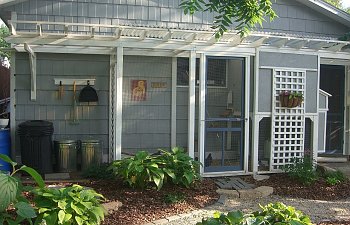

We downloaded plans from thegardencoop.com and built our own coop off the back of our garage during spring break... the First Ladies (Dolley and Abigail - the two "Martha" candidates turned out to be roosters - and Princess Leia) moved into the coop a month ago, and seem to enjoy their new digs!
Due to space constraints, I tweaked the dimensions of the coop somewhat from those in the plans, but was able to use most of the construction plans to ensure a good build. I chose to sink 4x4 lumber below the frost line for the front support posts, and buried hardware cloth a foot deep around the perimeter to keep varmints out, too.
We extended pergola-style roof trusses off both ends of the coop, as we had extra space along the garage wall. One end of the roofline extends over the garage back door (hopefully for easier access to the egg door and supplies during the winter months), and the other shelters our feed and bedding bins and utility/cleanup area. To shield the run from the neighbor's view, we added a trellis which will soon host climbing vines on that end, too. Because the coop roof slants to the rear, and since we chose to build it attached to our existing garage, I ran a length of rain gutter along the back wall of the coop which empties into a rain barrel near the utility area.
We found a kitchen cabinet at our local ReStore to mount below the external egg box (also fashioned after the plans on thegardencoop.com) to store easy-access supplies like grit, scratch and feed, and painted it to match the rest of the coop. They also had remnant linoleum which I used for our henhouse floor. Rather than building our own coop door, we found two identical screen doors at the ReStore, one of which I re-screened with hardware cloth for the coop, and the other I installed on the garage people-door to match.


I was able to find a plug-in, thermostat-controlled lamp switch for our heat lamp and a fan inside the henhouse - well worth the investment in this springtime's cool nights and this summer's recent heat. A remote thermostat sensor lets us know the temp inside the henhouse from our kitchen window area; southern Wisconsin has most extremes as far as temperatures are concerned... we haven't yet double-insulated the henhouse walls, but we'll see how things go.

